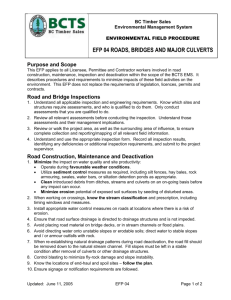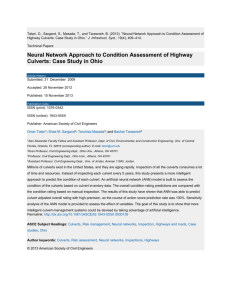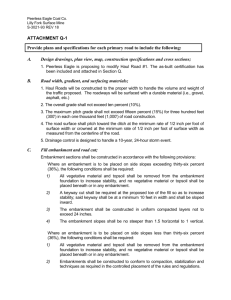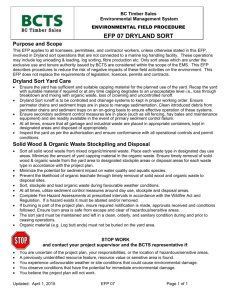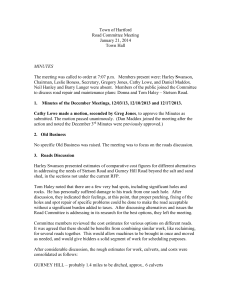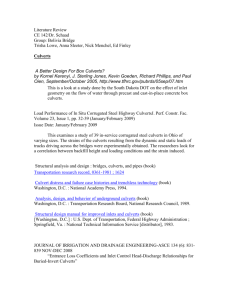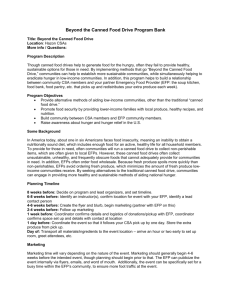EFP-04-Roads-Bridges
advertisement
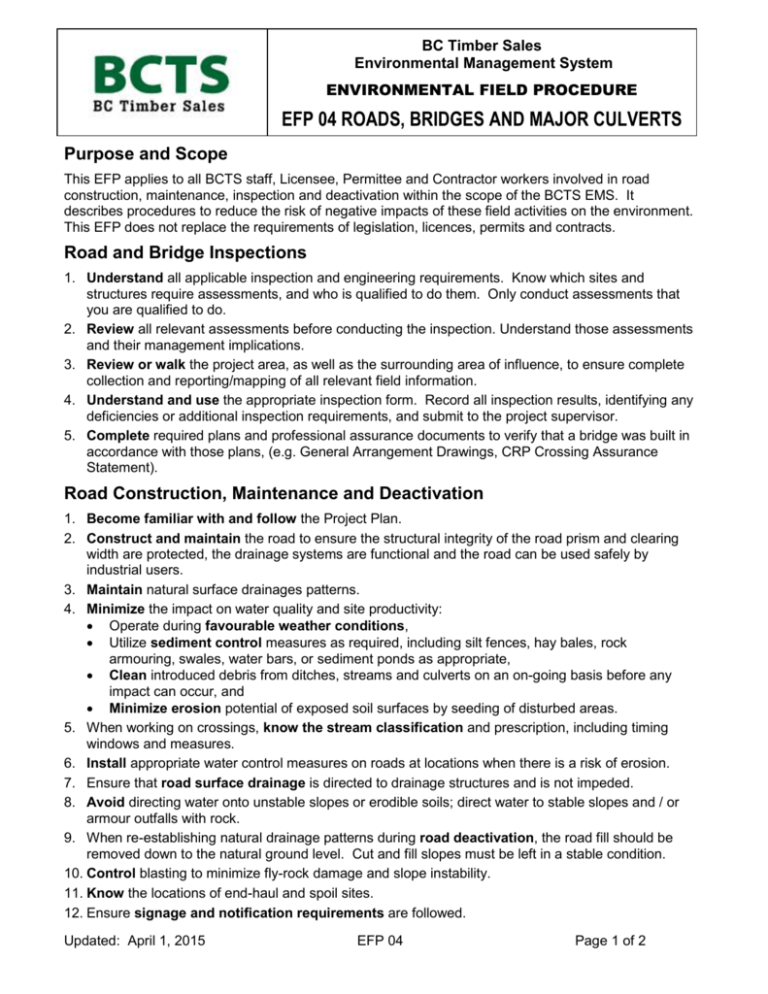
BC Timber Sales Environmental Management System ENVIRONMENTAL FIELD PROCEDURE EFP 04 ROADS, BRIDGES AND MAJOR CULVERTS Purpose and Scope This EFP applies to all BCTS staff, Licensee, Permittee and Contractor workers involved in road construction, maintenance, inspection and deactivation within the scope of the BCTS EMS. It describes procedures to reduce the risk of negative impacts of these field activities on the environment. This EFP does not replace the requirements of legislation, licences, permits and contracts. Road and Bridge Inspections 1. Understand all applicable inspection and engineering requirements. Know which sites and structures require assessments, and who is qualified to do them. Only conduct assessments that you are qualified to do. 2. Review all relevant assessments before conducting the inspection. Understand those assessments and their management implications. 3. Review or walk the project area, as well as the surrounding area of influence, to ensure complete collection and reporting/mapping of all relevant field information. 4. Understand and use the appropriate inspection form. Record all inspection results, identifying any deficiencies or additional inspection requirements, and submit to the project supervisor. 5. Complete required plans and professional assurance documents to verify that a bridge was built in accordance with those plans, (e.g. General Arrangement Drawings, CRP Crossing Assurance Statement). Road Construction, Maintenance and Deactivation 1. Become familiar with and follow the Project Plan. 2. Construct and maintain the road to ensure the structural integrity of the road prism and clearing width are protected, the drainage systems are functional and the road can be used safely by industrial users. 3. Maintain natural surface drainages patterns. 4. Minimize the impact on water quality and site productivity: Operate during favourable weather conditions, Utilize sediment control measures as required, including silt fences, hay bales, rock armouring, swales, water bars, or sediment ponds as appropriate, Clean introduced debris from ditches, streams and culverts on an on-going basis before any impact can occur, and Minimize erosion potential of exposed soil surfaces by seeding of disturbed areas. 5. When working on crossings, know the stream classification and prescription, including timing windows and measures. 6. Install appropriate water control measures on roads at locations when there is a risk of erosion. 7. Ensure that road surface drainage is directed to drainage structures and is not impeded. 8. Avoid directing water onto unstable slopes or erodible soils; direct water to stable slopes and / or armour outfalls with rock. 9. When re-establishing natural drainage patterns during road deactivation, the road fill should be removed down to the natural ground level. Cut and fill slopes must be left in a stable condition. 10. Control blasting to minimize fly-rock damage and slope instability. 11. Know the locations of end-haul and spoil sites. 12. Ensure signage and notification requirements are followed. Updated: April 1, 2015 EFP 04 Page 1 of 2 13. Prepare and submit drawings and documentation of professional conformance as required. Bridge or Major Culvert Installation, Maintenance and Removal 1. Become familiar with and follow the Project Plan. 2. Construct and maintain the bridges, culverts, fords and other structures associated with the road so that they are structurally sound and safe for use by industrial users. 3. Ensure the work complies with timing windows and other specifications. 4. Plan to install culverts in one day if feasible. 5. Pre-mark the inlet and outlet location of all pipes to ensure they fit to the edges of the road prism. Accommodate skew, slope and amount of embedment, as designed. 6. Know the stream classification and prescriptions for the watercourses affected by the works. 7. Minimize the impact on water quality and site productivity: Operate during favourable weather conditions. Know the project shut-down criteria, Utilize sediment control measures as required, including silt fences, hay bales, or sediment ponds as appropriate, Clean introduced debris from ditches, streams and culverts on an on-going basis, and before any blockages can occur, and Minimize erosion potential of exposed soil surfaces by seeding of disturbed areas. 8. Avoid placing erodible materials on bridge decks, in stream channels or on flood plains. 9. Avoid directing water onto unstable slopes or erodible soils; direct water to stable slopes and / or armour outfalls with rock. 10. In non-fish culvert installations, armour the inflows, outflows and fill slopes to minimize erosion, as required or practicable. 11. Dispose of wood culvert/bridge debris in designated sites, outside riparian management areas, or according to pre-work instructions. 12. Prepare and submit drawings and professional conformance documents as required. Fire Hazard Assessment and Abatement 1. Complete Hazard Assessments at prescribed intervals in accordance with the Wildfire Act and Regulation. 2. Create and follow the Project Plan for Abatement if required following the assessment. 3. If burning is part of the Project Plan for abatement, ensure required notification is made, approvals received and conditions followed. Ensure burn area is safe from escape and clear of hazardous or sensitive areas. Monitor burned sites for extinguishment. STOP WORK and contact your project supervisor and the BCTS representative if: You are uncertain of the Project Plan, your responsibilities, or the location of hazardous/sensitive areas. A previously unidentified resource feature, resource value (e.g. cultural) or sensitive area is found. You experience unfavourable weather or site conditions that could cause environmental damage. You observe conditions that have the potential for immediate environmental damage. You believe the Project Plan will not work. Updated: April 1, 2015 EFP 04 Page 2 of 2
